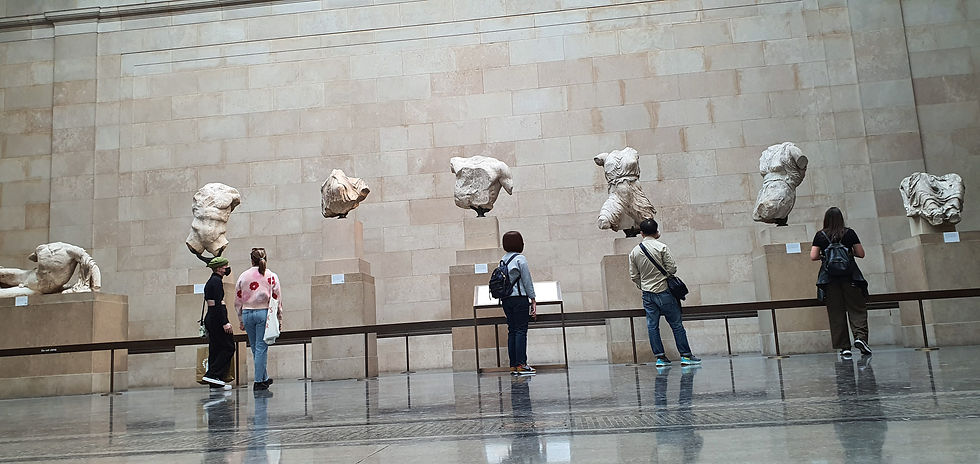Possession is nine-tenths of ownership.
- Dougie
- May 20, 2022
- 3 min read
We visited the British Museum today (for the first time in my life -- strangely enough, given I used to work less than half a mile distant in Endsleigh Street). We had arranged to meet a friend of Spike's from Middle School when they were both 10. Kate works for the Science Museum Group so her choice of meeting place was a bit like a bus driver's holiday in some respects. But we had tickets to see a new exhibition: Feminine power -- the divine to the demonic. More of which later.
The British Museum houses an astonishing collection of art and artefacts. The indisputable 'tag line' on the museum's web site is "Discover two million years of human history and culture." Who could argue with that great claim?

Quite a few folk, it would seem.
Most famously / notoriously there are the Parthenon Marbles which used to be known as the Elgin Marbles and which the Greek government and people would like to have returned to Athens -- where the Parthenon museum awaits.
Less well known are 'Benin Bronzes' -- thousands of bronze plaques dating from the 13th to 15th Centuries. They were looted -- there is no other word for it -- from what is now Nigeria during a British colonial "expedition" in 1897.
Cambodia has expressed its interest in over 100 artefacts in the Museum that seem to have been acquired or collected by who knows who then passed through a now dead art dealer called Douglas Latchford.
There is a much longer list.
So once again I find myself internally conflicted by my own messy contradictions. I sat in the stunning, minimalist Parthenon Gallery genuinely in awe of both the space and its contents. But I also wondered simultaneously if it is not long past time to return the large collection of stone marvels to the place where they were taken from. The place to which they belong.
More personally (in an odd little way). In Room 55 there is "The Flood Tablet" from the library of Assyrian King Ashurbanipal (who reigned between 669–631BCE). In 2018 I wrote my 20,000 word Honours Degree dissertation on the emergence of secular Apocalypse fiction in the early 19th Century. Read Mary Shelley's fourth novel, The Last Man, if you're interested. Pertinent to our recent past the novel is about a plague Apocalypse but -- spoiler alert -- it does not end happily for anyone. The clue is in the title.

This is Tablet 11 of The Epic of Gilgamesh (the earliest known epic poem in literature). Its cuneiform script was chiseled into soft stone maybe 3,000 years ago. It tells an Akkadian (Babylonian) version of a great flood and the survival of the world's oldest man, Utnapishtim and his family.
So, it's a different version of the Noah story. I used both of them (and other versions -- because there are many across many cultures) to establish the original Sacred paradigm of apocalyptic fiction that Mary Shelley shifted irrevocably.
Still with me? Probably not. But think of it this way. No Mary Shelley secular Apocalypse there can be no Thanos. And without Thanos -- neither Avengers: Infinity War nor Avengers: End Game make any sense at all. Why do you think he has that Mesopotamian chin?
Anyway.
I wanted to sit in Room 55 of the British Museum to look at, wonder and photograph a 3,000 year old stone Tablet with part of an old Babylonian poem that helped me secure a First Class Honours Degree in literature from the Australian National University. So how conflicted and contradictory am I?
As Kate, Spike and I toured the 'Feminine Power' exhibition these collecting / curating / viewing contradictions kept niggling away at me. Kate and Spike too, I think.
There were Aphrodite, Minerva, Sekhmet and Isis in the exhibition. All 'collected' or 'acquired' in the 19th Century and now part of the permanent collection of the British Museum. All fabulous, moving, thought-provoking works of art (these days) that served some other purpose long ago in places other than -- and a long way from -- a big, post-imperial museum in Bloomsbury.




These are complex, contested questions to which there are no simple, easy answers (although some artefacts -- from the Parthenon and Benin -- seem much less complicated than others). I was pleased to sit in awe of works made thousands of years ago by unknown artisans. I enjoyed the exhibition.
But like every other visitor intending to see as much of the British Museum's 2 million years and more of material, we felt a need to pace ourselves. So -- nothing resolved as usual -- we found the third floor restaurant and talked our way through lunch.





Comments